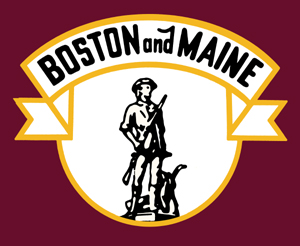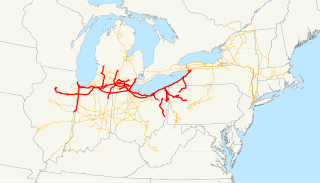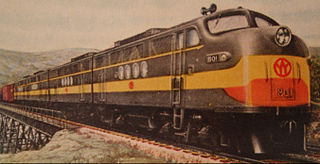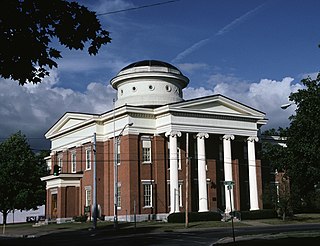
The Boston and Maine Corporation, known as the Boston and Maine Railroad (B&M), was a U.S. Class I railroad in northern New England. It became part of what is now the Pan Am Railways network in 1983.

The New York Central Railroad was a railroad primarily operating in the Great Lakes region of the United States. The railroad primarily connected greater New York and Boston in the east with Chicago and St. Louis in the Midwest along with the intermediate cities of Albany, Buffalo, Cleveland, Cincinnati, and Detroit. New York Central was headquartered in New York City's New York Central Building, adjacent to its largest station, Grand Central Terminal.

The Lake Shore and Michigan Southern Railway, established in 1833 and sometimes referred to as the Lake Shore, was a major part of the New York Central Railroad's Water Level Route from Buffalo, New York, to Chicago, Illinois, primarily along the south shore of Lake Erie and across northern Indiana. The line's trackage is still used as a major rail transportation corridor and hosts Amtrak passenger trains, with the ownership in 1998 split at Cleveland between CSX to the east, and Norfolk Southern in the west.

The Central New England Railway was a railroad from Hartford, Connecticut and Springfield, Massachusetts west across northern Connecticut and across the Hudson River on the Poughkeepsie Bridge to Maybrook, New York. It was part of the Poughkeepsie Bridge Route, an alliance between railroads for a passenger route from Washington to Boston, and was acquired by the New York, New Haven & Hartford Railroad in 1904.

The Boston and Albany Railroad was a railroad connecting Boston, Massachusetts to Albany, New York, later becoming part of the New York Central Railroad system, Conrail, and CSX Transportation. The line is currently used by CSX for freight. Passenger service is still operated on the line by Amtrak, and by the MBTA Commuter Rail system, which owns and uses the section east of Worcester as their Framingham/Worcester Line.

The Old Colony Railroad (OC) was a major railroad system, mainly covering southeastern Massachusetts and parts of Rhode Island. It operated from 1845 to 1893. Old Colony trains ran from Boston to points such as Plymouth, Fall River, New Bedford, Newport, Providence, Fitchburg, Lowell and Cape Cod. For many years the Old Colony Railroad Company also operated steamboat and ferry lines, including those of the Fall River Line with express train service from Boston to its wharf in Fall River where passengers boarded luxury liners to New York City. The company also briefly operated a railroad line on Martha's Vineyard, as well as the freight-only Union Freight Railroad in Boston. The OC was named after the "Old Colony", the nickname for the Plymouth Colony.

The Central Massachusetts Railroad was a railroad in Massachusetts. The eastern terminus of the line was at North Cambridge Junction where it split off from the Middlesex Central Branch of the Boston and Lowell Railroad in North Cambridge and through which it had access to North Station in Boston. From there, the route ran 98.77 miles west through the modern-day towns of Belmont, Waltham, Weston, Wayland, Sudbury, Hudson, Bolton, Berlin, Clinton, West Boylston, Holden, Rutland, Oakham, Barre, New Braintree, Hardwick, Ware, Palmer, Belchertown, Amherst, and Hadley to its western terminal junction at N. O. Tower in Northampton with the Connecticut River Railroad.

The West Shore Railroad was the final name of a railroad that ran from Weehawken, New Jersey, which is across the Hudson River from New York City, north along the west shore of the river to Albany, New York and then west to Buffalo. It was organized as a competitor to the New York Central and Hudson River Railroad, but was soon taken over by that company.

New York State Railways was a subsidiary of the New York Central Railroad that controlled several large city streetcar and electric interurban systems in upstate New York. It included the city transit lines in Rochester, Syracuse, Utica, Oneida and Rome, plus various interurban lines connecting those cities. New York State Railways also held a 50% interest in the Schenectady Railway Company, but it remained a separate independent operation. The New York Central took control of the Rochester Railway Company, the Rochester and Eastern Rapid Railway and the Rochester and Sodus Bay Railway in 1905, and the Mohawk Valley Company was formed by the railroad to manage these new acquisitions. New York State Railways was formed in 1909 when the properties controlled by the Mohawk Valley Company were merged. In 1912 it added the Rochester and Suburban Railway, the Syracuse Rapid Transit Railway, the Oneida Railway, and the Utica and Mohawk Valley Railway. The New York Central Railroad was interested in acquiring these lines in an effort to control the competition and to gain control of the lucrative electric utility companies that were behind many of these streetcar and interurban railways. Ridership across the system dropped through the 1920s as operating costs continued to rise, coupled with competition from better highways and private automobile use. New York Central sold New York State Railways in 1928 to a consortium led by investor E. L. Phillips, who was looking to gain control of the upstate utilities. Phillips sold his stake to Associated Gas & Electric in 1929, and the new owners allowed the railway bonds to default. New York State Railways entered receivership on December 30, 1929. The company emerged from receivership in 1934, and local operations were sold off to new private operators between 1938 and 1948.
The Housatonic Railroad is a Class III railroad operating in southwestern New England. It was chartered in 1983 to operate a short section of ex-New York, New Haven and Hartford Railroad in northwestern Connecticut, and has since expanded north and south, as well as west into New York State.

The New York, Ontario and Western Railway, more commonly known as the O&W or NYO&W, was a regional railroad with origins in 1868, lasting until March 29, 1957 when it was ordered liquidated by a US bankruptcy judge. It was the first notable U.S. railroad with its mainline entirely abandoned.
The North Pennsylvania Railroad was a railroad company which served Philadelphia, Montgomery County, Bucks County and Northampton County, Pennsylvania. It was formed in 1852 and began operation in 1855. The Philadelphia and Reading Railway, predecessor to the Reading Company, leased the North Pennsylvania in 1879. Its tracks were transferred to Conrail and the Southeastern Pennsylvania Transportation Authority (SEPTA) in 1976.

The Lycoming Valley Railroad is a short line that operates 38 miles (61 km) of track in Lycoming and Clinton counties in Pennsylvania in the United States. It is part of the North Shore Railroad System.
The Allentown Railroad was a rail line proposed in the 1850s to connect the Central Railroad of New Jersey at Allentown with the Pennsylvania Railroad's main line across the Allegheny Mountains. Though grading was almost entirely finished, the project was halted by the Panic of 1857, and the completion of the East Pennsylvania Railroad in 1859 made the Allentown Railroad's proposed line largely redundant. As a result, track was never laid on most of the line. The small portion that did became a branchline of the Reading Company from Topton to Kutztown, and was nominally owned by the Allentown Railroad until the Reading dissolved it in 1945 to simplify corporate bookkeeping. Other Reading subsidiaries also laid track on parts of the right-of-way elsewhere along the route.

The Harrisburg Line is a rail line owned and operated by the Norfolk Southern Railway (NS) in the U.S. Commonwealth of Pennsylvania. The line runs from Philadelphia west to Harrisburg, Pennsylvania.

The Boston, Clinton, Fitchburg and New Bedford Railroad was a railroad in Massachusetts. It was formed on June 1, 1876, when the Boston, Clinton and Fitchburg Railroad merged with the New Bedford Railroad. The Boston, Clinton and Fitchburg Railroad connected with the key railroad hubs of Worcester, Framingham, and Ayer, as well as several important industrial towns such as Fitchburg and Lowell, with the latter coming through a lease of the Framingham and Lowell Railroad. The New Bedford Railroad linked Framingham with New Bedford, which was a key deep-water port.

Railroads in Syracuse, New York, were first mentioned in October 1831, when a convention held in the city marked one of the earliest moves to stimulate the era of railroad building which ultimately brought steam railroad service to New York State. At the time of the convention, the oldest railroad in Onondaga County had been in operation for two years.
The Mansfield and Framingham Railroad was a railroad in Massachusetts. It was incorporated in 1862 as the Foxborough Branch Railroad to provide a rail connection from Mansfield through Foxborough to Walpole. However, the name of the company was changed in 1867 to Mansfield and Framingham Railroad with a new charter allowing it to connect to the Boston, Clinton and Fitchburg Railroad line at Framingham.
The Gilman, Clinton and Springfield Railroad was a railroad of 111 miles in length, chartered in 1867, that operated from 1871 until 1877 in the U.S. state of Illinois. It provided service from Springfield, the state capital, to Gilman, a junction point on the main line of the much larger Illinois Central Railroad. After operation for a short period as an independent short line, the Gilman, Clinton and Springfield underwent financial failure and was merged into the Chicago and Springfield Railroad, an affiliate of the Illinois Central.















